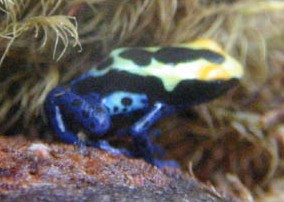Poison dart frog
| True Frogs | |||||||||||||||
|---|---|---|---|---|---|---|---|---|---|---|---|---|---|---|---|
:
| |||||||||||||||
| Genera | |||||||||||||||
| Many, about 150+ species within 8 genus | |||||||||||||||
The term Poison Dart Frog is the common name given to the group of frogs belonging to the family of Dendrobatae. This group of frogs has many common names including: poison arrow frogs, poison frogs, or simply dart frogs.
Background
These frogs recieved their common name from the toxic skin a few species posses, such as the most poisonous dart frog Dendrobates terribilis. The natives of South America dip their arrows for hunting in the toxins found on the skin of these frogs (the poison is collected via roasting the frogs and the toxin dripping into a cup). This way by shooting a poison-tipped arrow at a wild animal, the animal will die within minutes from the neuro-toxin covering the arrowhead instead of the native having to make additional shots to kill the animal.
Poison dart frogs are traditionally characterized by their brightly colored skin and small size. Their skin color for example, can range from bright orange and black to true blue, to yellow, blue, and black spots.
Poison dart frogs are only found in three geographical regions: Central America, South America, and on a few of the islands that comprise the state of Hawaii. In Hawaii, only one species found in the wild, the green and black poison dart frog, also known by it's genus species: Dendrobates auratus. It is believed that the species was actually introduced to the islands during the 19th or 20th centuries by man.
There are well over 100 different species of poison dart frog found in the wild. Only a handful are actually toxic to animals and humans. It is believed the few species that are toxic become so by their diet which consist in part of Carpenter ants. It is believed that these ants eat an unknown wild plant which has toxic properties. These toxins are passed from the plant to the ant to the poison dart frog which is then digested and secreted on the outside of the amphibian's skin. Because of this, in captivity, all species of poison dart frog are completely harmless since their diet is not the same as it is in the wild. Interestingly enough, frogs brought from the wild into captivity and fed a regular captive diet (usually fruit flies or pin-head crickets) become completely non-toxic in about a month.
Above is a picture of a juvenile Dendrobates tinctorius also referred to as simply a "Cobalt Tinc". The frog above is about 3-6 months old.
Poison dart frogs range in size from 1/2" to 2 1/2" long when fully grown. Size not only depends on age of the frog but also what species. The species Dendrabates tinctorius is one of the larger species reaching 2 1/2" in size while smaller species, like Dendrobates imitator doesn't reach much more than an inch when fully grown.
Posion dart frogs have a typical lifespan of anywhere from 5 to 12+ years. Most species of poison dart frog reach maturity around 1.5 to 2.5 years of age. The easiest way to determine the sex of a particular species of posion dart frog is by observing them in the wild. Male frogs that have reached maturity will make a mating call usually after eating or after a heavy misting of water. The sound sounds similar to that of a series of high-pitched "clicks". In juvenile frogs sometimes the sex can be determined by looking at the profile of the amphibian. Males usually have their backs slope down with less of a break than females. Females are usually more rounder and show a bigger break in their profile.
In captivity, most species thrive where humidity is kept around 80-100% constantly and temperature hovers around 80-82 F degrees during the day and no lower than 60-65 F degrees at night.
Poison dart frogs are sometimes confused with Mantellas, a small colorful frog only found on the island of Madagascar. These two families of frogs are not related and Mantellas typically prefer cooler temperatures, are non-poisonous and usually smaller in size than the medium to large species of poison dart frogs.
-- Troy McHenry

